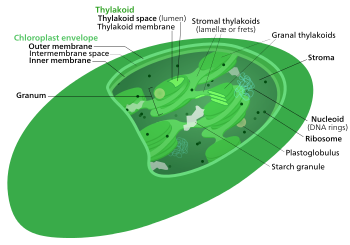
Back حلقة كالفن Arabic Calvinov ciklus BS Cicle de Calvin Catalan سووڕی کاڵڤین CKB Calvinův cyklus Czech Calvin-cyklus Danish Calvin-Zyklus German Κύκλος του Κάλβιν Greek Ciclo de Calvin Spanish Calvini tsükkel Estonian
The Calvin cycle, light-independent reactions, bio synthetic phase, dark reactions, or photosynthetic carbon reduction (PCR) cycle[1] of photosynthesis is a series of chemical reactions that convert carbon dioxide and hydrogen-carrier compounds into glucose. The Calvin cycle is present in all photosynthetic eukaryotes and also many photosynthetic bacteria. In plants, these reactions occur in the stroma, the fluid-filled region of a chloroplast outside the thylakoid membranes. These reactions take the products (ATP and NADPH) of light-dependent reactions and perform further chemical processes on them. The Calvin cycle uses the chemical energy of ATP and the reducing power of NADPH from the light-dependent reactions to produce sugars for the plant to use. These substrates are used in a series of reduction-oxidation (redox) reactions to produce sugars in a step-wise process; there is no direct reaction that converts several molecules of CO2 to a sugar. There are three phases to the light-independent reactions, collectively called the Calvin cycle: carboxylation, reduction reactions, and ribulose 1,5-bisphosphate (RuBP) regeneration.
Though it is also called the "dark reaction", the Calvin cycle does not occur in the dark or during nighttime. This is because the process requires NADPH, which is short-lived and comes from light-dependent reactions. In the dark, plants instead release sucrose into the phloem from their starch reserves to provide energy for the plant. The Calvin cycle thus happens when light is available independent of the kind of photosynthesis (C3 carbon fixation, C4 carbon fixation, and crassulacean acid metabolism (CAM)); CAM plants store malic acid in their vacuoles every night and release it by day to make this process work.[2]
- ^ Silverstein, Alvin (2008). Photosynthesis. Twenty-First Century Books. p. 21. ISBN 9780822567981.
- ^ Cushman, John C. (2001). "A plastic photosynthetic adaptation to arid environments". Plant Physiology. 127 (4): 1439–1448. doi:10.1104/pp.010818. PMC 1540176. PMID 11743087.
